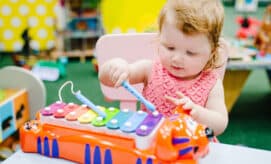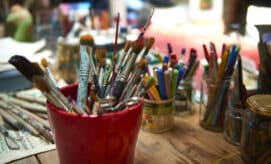Because early learning programs often have a limited budget, teachers work hard to find clever, unique, low-budget materials to use in their classroom. Recycled materials, also referred to as “found materials,” are easy to access, versatile, and economical. They can be incorporated into a variety of classroom activities, such as canvases and materials for art, and loose parts for construction projects. In addition, offering recycled materials to children creates an opportunity to talk with them about sustainability, eliminating waste, and reusing valuable products.
From plastic containers to cardboard boxes to toilet paper rolls, the possibilities really are endless for what can be salvaged and re-used as classroom materials.
Open-Ended Experiences to Support Development
Recycled materials can inspire imagination by offering children opportunities to explore and create new forms of art, building, and design.
Nancy Howe, Head Teacher from Stanford University’s Bing Nursery School, shares how children can develop foundational math and science skills with the help of found materials. “When given an assortment of materials, children have the opportunity to practice sorting, categorizing, counting, exploring the concept of parts and whole, matching, pattern making, and spatial arrangement. Found materials can engage young children in an exploration of scientific phenomena and natural sciences in an engaging, developmentally appropriate way.”
Howe adds that social engagement and language development can be encouraged with the help of recycled materials. As they explore recycled materials, children interact with peers and learn valuable social skills by collaborating and sharing techniques. As children articulate and express what they have made, how it works, and how they feel about their design, they practice abstract thinking and using new words to enhance thoughts and ideas.
Materials to Collect and Save






